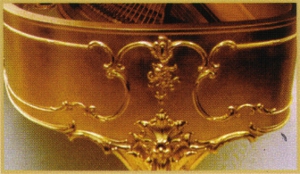Piano’s Sound Rated 24 Karat
Music: THE GILT STEINWAY IS A MARVEL OF A BYGONE TIME, WHEN CRAFTSMEN SPENT YEARS ON INSTRUMENTS.
By NANCY WRIDE
TIMES STAFF WRITER
This is the tale of a 24-karat gold Steinway that would make Leberace drool.
First thought: Spectacky!
Third thought: Vegas?
But no, its new home-unless you want to buy it of course is in industrial Signal Hill. It sits in a tidy store with classic European pianos, in a neighborhood of new industrial offices and old dingy upholstery shops.
There, lifelong piano tuner Herlberto Lurgenstein and his partner are the keepers of the $ 1.2-million piano, commissioned in 1903 to mark Steinway & Sons’ 50th anniversary. A second piano, also gilt but boasting portraits of patriots from the original 13 colonies, is owned by the Smithsonian Institution in Washington.
In bright light the Signal hill instrument could make you squint. With the lights dimmed, and its life story told, the piano’s charm grows.
When the ivory keys create music, the deep, gorgeous sound is intoxicating. Even one handed “Heart and Soul” sounds good on this piano. One theory is that gold leaf mixed into the varnish is the instrument’s secret to almost organ-like amplification.
“It’s not a piano,” said a professional jazz pianist who works for a Steinway competitor. “It’s an orchestra.”
The life of this oddball piano and the caretakers who owned it along its unlikely path to Signal Hill are marvels of a bygone time, when craftsmen spent years on instruments and the piano was the heart of many a family parlor.
The instrument’s genealogy has been researched from Steinway to its present owner, who entrusted it to Lurgenstein, his friend of 30 years. And the history that follows is offered by Lurgenstein, an Argentine who immigrated in 1965 to Michigan and has rebuilt and restored pianos for major stage venues and the likes of Arthur Rubenstein and Victor Borge.
When the two special pianos were created, bodies were gilded in 24-karat. One was to be sold, the other presented to the White House as a gift to the country.
They were designed by the head of Steinway’s art case department, Joseph Burr Tiffany, a distant cousin of the famous Tiffany & Co. founder. Two famous Parisian woodcarvers were summoned to the Steinway factory on New York’s Long Island to build the mahogany pianos.
The first owner of the one now with Lurgenstein was a prominent New York banker, William Frederick Stafford, who lived in the Plaza Hotel. He died there in 1918, and his estate returned the piano to the Steinway company.
That year, Benjamin Sawtelle Hanchett, builder of the Grand Rapids, Holland & Lake Michigan Railway and a University of Michigan regent, bought the gold piano for his 16-year-old daughter, and it remained in the Hanchett family until an estate sale in the early 1980’s.
A Detroit piano company owner, George Michalski, purchased the instrument, and its rejuvenation began. Over 14 years, the internal parts of the instrument were restored. More recently, according to a cover story, in the Technicians Journal, the refinishing of the piano’s exterior commenced. The work was done by Glen Hart, who wrote the story about his gilding work. “The methods used,” he said, “were the true gilding methods of centuries past.”
A water gilding technique was employed on the intricately carved legs of the piano. Sheets of 24-karat gold were cut into 60,000 individual pieces for the finish on the piano case. In all, Hart said, the process took 16 months.
The owner got his good friend Lurgenstein to take custody. Even that was a major undertaking. No trucking firm would move the piano, unwilling to accept liability for an irreplaceable instrument. Lurgenstein had to fetch it himself.
He returned with the piano on a Wednesday in December. Initially Lurgenstein said, the thought was that it would get the white-glove treatment with a velvet rope perimeter. But instead that Sunday, they hosted a children’s piano recital.
It is hard to imagine the furnishings today that would hold their own beside this piano.
“This piano is extraordinary,” raved Wini Jackson, a 55-year-old gospel pianist from the South who visits the Pianocraft store regularly.
“The gold was put there, I think to beckon you to the piano. But it’s the mixture of the history of the piano and the sound, which has a very distinctive gut sound, that makes it ring true to a time before. Like a jewel that’s been lost and now it’s found.”
Herlberto Lurgenstein
Fully restored inside and out, George Michalski had a decision to make. Had the time come to send his Golden Grand back into the world? He turned to fellow piano craftsman and personal friend of thirty, Herlberto Lurgenstein. An Argentine, Herlberto worked on pianos for the likes of Arthur Rubenstein and Victor Borge.
Lurgenstein agreed to take the piano on consignment back to European Pianocraft in Signal Hill, California. On December 7th, 2001. Lurgenstein moved the piano from Michigan to California himself because no trucking firm was willing to accept liability for irreplaceable instrument.



